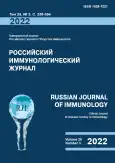Cytokine system in the patients with type 2 diabetes mellitus non-infected with SARS-CoV-2
- Authors: Savchuk K.S.1, Simbirtsev A.S.2
-
Affiliations:
- Center for Obstetrics and Gynecology No. 1
- Pasteur Institute of Epidemiology and Microbiology
- Issue: Vol 25, No 3 (2022)
- Pages: 295-298
- Section: SHORT COMMUNICATIONS
- URL: https://journals.rcsi.science/1028-7221/article/view/120200
- DOI: https://doi.org/10.46235/1028-7221-1129-CSI
- ID: 120200
Cite item
Full Text
Abstract
Diabetes mellitus (DM) is a common chronic non-communicable disease, being the most significant comorbidity in SARS-CoV-2 viral infection. The proportion of DM patients among those with COVID-19 is up to 25.0% in the Russian Federation. In presence of DM, clinical course of COVID-19 is characterized by greater severity and persistence of pulmonary damage, an increased need for immunosuppressive, glucocorticoid and combined antiviral therapy in COVID-19 patients, and with prolonged rehabilitation period. Pathogenetic effects of DM on severe course of the SARS-CoV-2 viral infection are being actively studied. The following factors were considered, e.g., negative impact of hyperglycemia on the course of infection; direct cytotoxic and indirect damage to pancreatic β-cells with further activation of pro-inflammatory mechanisms; cumulation and progression of generalized inflammation common to DM and COVID-19 including impaired production of cytokines; influence of SARS-CoV-2 virus on the renin-angiotensin-aldosterone system causing inhibition of insulin secretion and increased insulin resistance. Chronic inflammation and impaired immune response may be among the main mechanisms of association between type 2 DM (T2DM) and COVID-19. It is important to identify systemic inflammatory disorders in patients with type 2 diabetes, which may be associated with greater disease severity, being of negative prognostic value. The aim of the present work was to investigate concentrations of some serum cytokines in the patients with type 2 diabetes not infected with SARS-CoV-2.
The study included 20 patients with type 2 diabetes; the control group consisted of 11 clinically healthy volunteers. The serum concentration of 13 cytokines was assessed by multiplex analysis on a MAGPIX-100 immunoanalyzer using a Merck multiplex analysis kit (Germany), in accordance with the manufacturer’s instructions.
Increased serum concentrations in T2DM patients were found, as compared with the control group for some key pro-inflammatory cytokines: CX3CL1, TNFα, IFNγ, IL-8, IL-17A, MIP-1α, and MIP-1β. We have also revealed a decrease in serum concentrations of IL-4. Serum immunoregulatory cytokines in the T2DM were found to be changed in different directions: a decrease in IL-5, along with increase of IL-12p70 and IL- 17, whereas the serum contents of IL-2, IL-13 did not change.
A comprehensive analysis of serum cytokine concentrations may increase clinical significance of assessing serum cytokine concentrations as prognostic and diagnostic markers, as well as therapeutic targets in type 2 DM, like as in SARS-CoV-2 infection.
Keywords
Full Text
##article.viewOnOriginalSite##About the authors
K. S. Savchuk
Center for Obstetrics and Gynecology No. 1
Author for correspondence.
Email: ksenyasavchuk@gmail.com
Clinical Endocrinologist
Russian Federation, ChelyabinskA. S. Simbirtsev
Pasteur Institute of Epidemiology and Microbiology
Email: ksenyasavchuk@gmail.com
PhD, MD (Medicine), Professor, Corresponding Member, Russian Academy of Sciences, Head, Laboratory of Medical Biotechnology
Russian Federation, St. PetersburgReferences
- Дедов И.И., Шестакова М.В., Майоров А.Ю., Викулова О.К., Галстян Г.Р., Кураева Т.Л., Петеркова В.А., Смирнова О.М., Старостина Е.Г., Суркова Е.В., Сухарева О.Ю., Токмакова А.Ю., Шамхалова М.Ш., Ярек-Мартынова И.Р., Артемова Е.В., Бешлиева Д.Д., Бондаренко О.Н., Волеводз Н.Н., Григорян О.Р., Гомова И.С., Джемилова З.Н., Есаян Р.М., Ибрагимова Л.И., Калашников В.Ю., Кононенко И.В., Лаптев Д.Н., Липатов Д.В., Мотовилин О.Г., Никонова Т.В., Роживанов Р.В., Шестакова Е.А. Алгоритмы специализированной медицинской помощи больным сахарным диабетом. Под ред. И.И. Дедова, М.В. Шестаковой, А.Ю. Майорова. 9-й выпуск // Сахарный диабет, 2019. Т. 22, № 1S1. С. 1-144. [Dedov I.I., Shestakova M.V., Mayorov A.Y., Vikulova O.K., Galstyan G.R., Kuraeva T.L., Peterkova V.A., Smirnova O.M., Starostina E.G., Surkova E.V., Sukhareva O.Y., Tokmakova A.Y., Shamkhalova M.S., Jarek-Martynova I.R., Artemova E.V., Beshlieva D.D., Bondarenko O.N., Volevodz N.N., Grigoryan O.R., Gomova I.S., Dzhemilova Z.N., Esayan R.M., Ibragimova L.I., Kalashnikov V.Y., Kononenko I.V., Laptev D.N., Lipatov D.V., Motovilin O.G., Nikonova T.V., Rozhivanov R.V., Shestakova E.A. Standards of specialized diabetes care. Edited by Dedov I.I., Shestakova M.V., Mayorov A.Yu. 9th edition. Sakharnyy diabet = Diabetes Mellitus, 2019, Vol. 22, no. 1S1, pp. 1-144. (In Russ.)]
- Abdel-Moneim A., Bakery H.H., Allam G. The potential pathogenic role of IL-17/Th17 cells in both type 1 and type 2 diabetes mellitus. Biomed. Pharmacother., 2018, Vol. 101, pp. 287-292.
- Pan X., Kaminga A.C., Wen S.W., Liu A. Chemokines in prediabetes and type 2 diabetes: A meta-analysis. Front. Immunol., 2021, Vol. 12, 622438. doi: 10.3389/fimmu.2021.622438.
- Pirola L., Ferraz J.C., World J. Role of pro- and anti-inflammatory phenomena in the physiopathology of type 2 diabetes and obesity. Biol. Chem., 2017, Vol. 8, no. 2, pp. 120-128.
- Schinzari F., Tesauro M., Campia U., Cardillo C. Vascul Pharmacol. Increased fractalkine and vascular dysfunction in obesity and in type 2 diabetes. Effects of oral antidiabetic treatment. Vascul. Pharmacol., 2020, Vol. 128-129, 106676. doi: 10.1016/j.vph.2020.106676.
- Ye J., Wang Y., Wang Z., Liu L., Yang Z., Wang M., Xu Y., Ye D., Zhang J., Lin Y., Ji Q., Wan J. Roles and mechanisms of interleukin-12 family members in cardiovascular diseases: opportunities and challenges. Front. Pharmacol., 2020, Vol. 11, 129. doi: 10.3389/fphar.2020.00129.
Supplementary files







